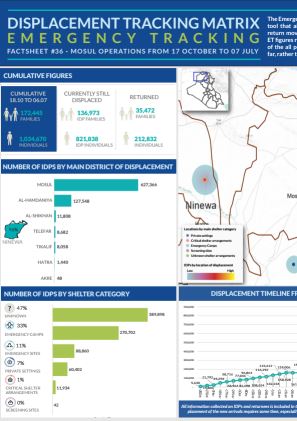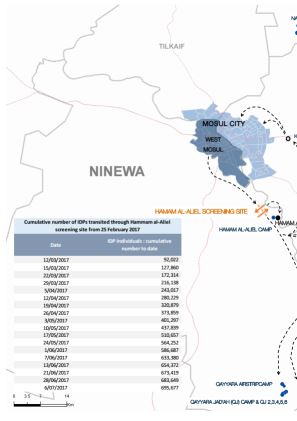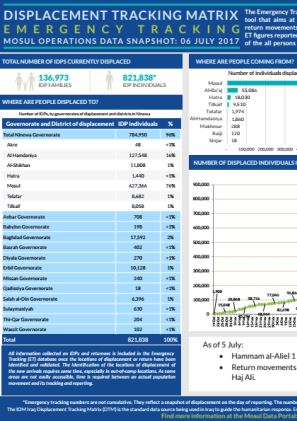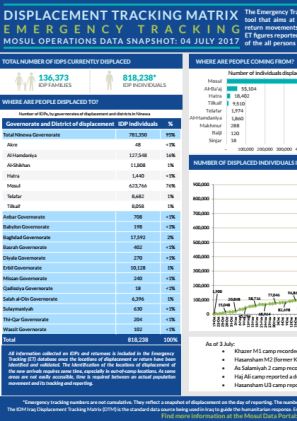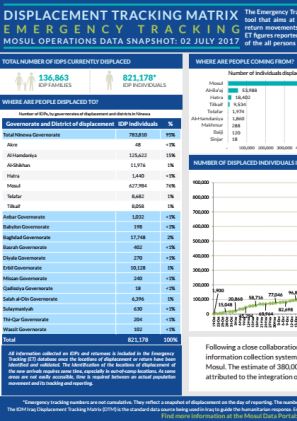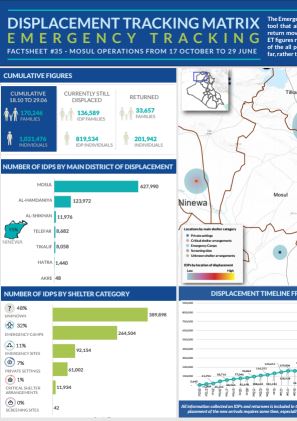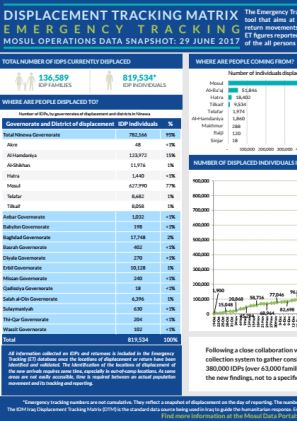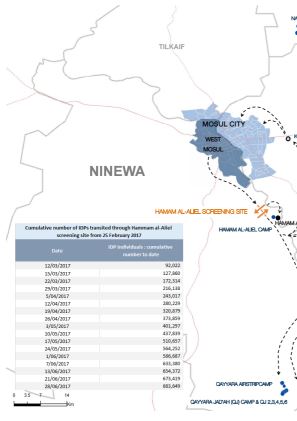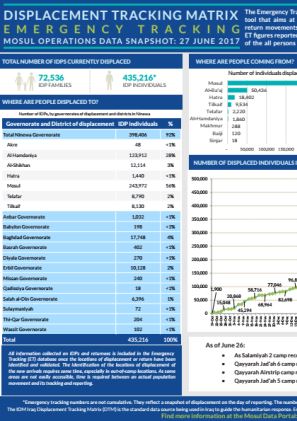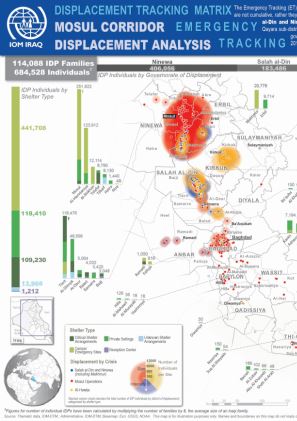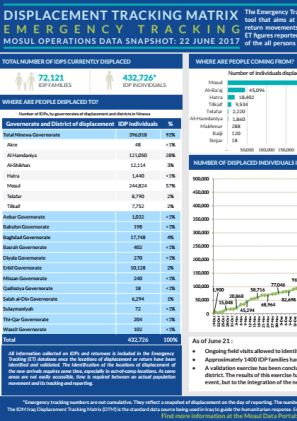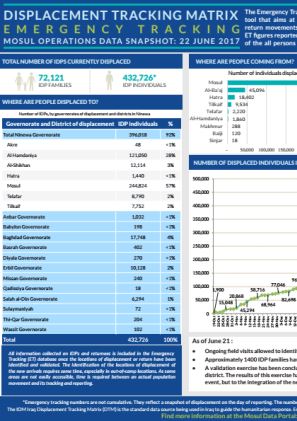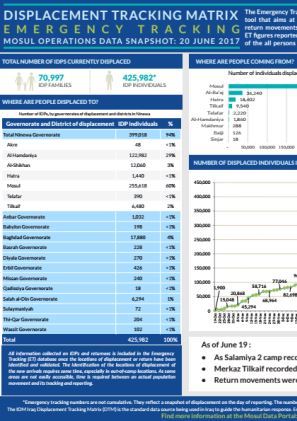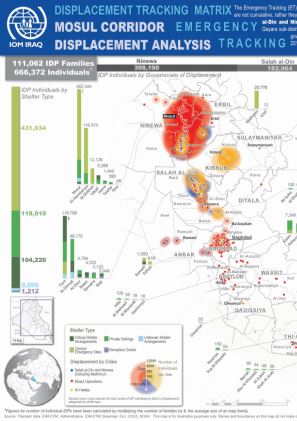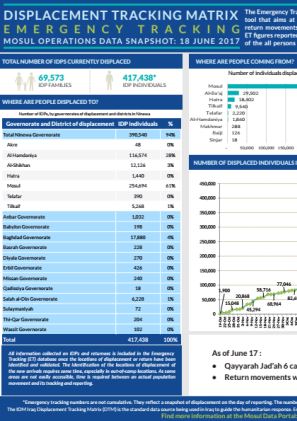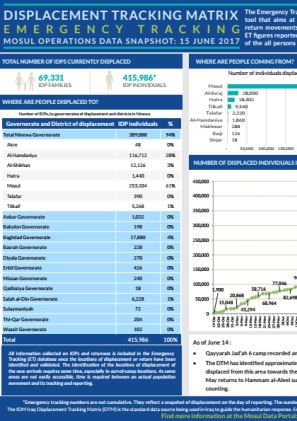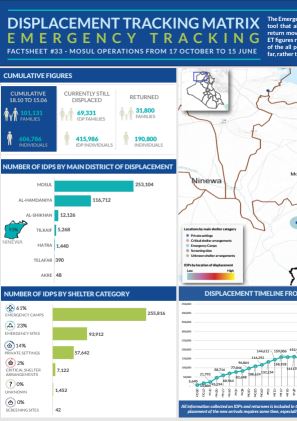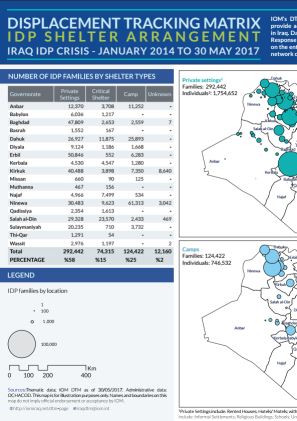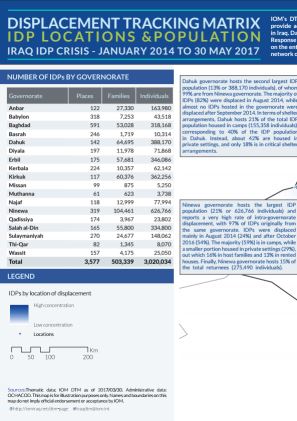-
Countries
-
Data and Analysis
-
Special Focus
-
Crisis Responses
Iraq
Suivi des PDI
Mouvements de déplacement
1,124,000
IDMC 2023
cycle de collecte de données
À propos Iraq
Reinforced in January 2014 in response to the need for information on displacement linked to the worsening armed conflict, the DTM programme in Iraq collects key information on internally displaced persons (IDPs) and returnees through different components and methodologies across the entire country.
Through IOM's Rapid Assessment and Response Teams (RARTs) -composed of 140 field staff- present throughout the Iraqi territory, the DTM collects data on numbers and locations of IDPs and returnees using an extended network of over 4,000 key informants. In addition to information collected from key informants, identified locations hosting IDPs are then visited and directly assessed by the RARTs to collect more detailed and in-depth information on the displaced population.
Please visit the Access to Durable Solutions among IDPs in Iraq
Iraq— Emergency Tracking Factsheet 36 (7 July 2017)
DTM identified 136,973 IDP families (comprised of 821,838) who are currently still displaced. DTM also identified 212,832 returnees comprising 35,472 families. The main district of displacement is Mosul where 627,366 individuals were identified.
Iraq — West Mosul Displacement Overview (6 July 2017)
Military operations in west Mosul led to the dis-placement of thousands of individuals to camps and out-of-camp locations, which are continuously being identified and monitored, when ac-accessible, by the DTM team.
Iraq — Mosul Operations Data Snapshot (6 July 2017)
During the reporting period DTM identified 136,973 displaced households comprised of 821,838 individuals.
Iraq — Mosul Operations Data Snapshot (4 July 2017)
DTM identified 136,373 Families comprised of 818,238 displaced individuals. Of these 730,962 reportedly originated from Mosul district. 389,898 are in unknown shelter arrangements and 355,518 are living in camps and emergency sites.
Iraq — Emergency Tracking Mosul Corridor Displacement Analysis (3 July 2017)
DTM identified 178,355 families comprising 1,079,130 individuals. 4, 38,966 are currently living in camps or emergency sites.
Iraq — Mosul Operations Data Snapshot (2 July 2017)
During this reporting period DTM identified 136,863 displaced families comprised of 821,178 individuals. The majority of the identified individuals (734,994) reported Mosul as their district of origin.
Iraq — Displacement Report 72 (May 2017)
As of 30 May 2017, the DTM has identified 3,020,034 internally displaced persons (503,339 families) displaced after January 2014, dispersed across 106 districts and 3,577 locations in Iraq. For the same period, DTM has identified 1,813,680 returnees (302,280 families).
Jun 29 2017
Iraq — Displacement Report 72 (May 2017)
Iraq — Emergency Tracking Factsheet 35 (29 June 2017)
The cumulative total of IDPs recorded by DTM from 17 October 2016 to 29 June 2017 is 1,021,476 individuals comprising 170,256 families. Of these, 819,534 individuals (comprising 136,589 families) are still displaced. 389,898 people are currently residing in unknown shelter arrangements.
Iraq — Mosul Operations Data Snapshot (29 June 2017)
As of 27 June 2017 DTM estimates that 136,589 households (819,534 individuals) are currently still displaced. The Majority of these IDPs (389,898) are living in unknown shelter arrangements and the most commonly reported district of origin was Mosul (735,492 individuals).
Iraq — West Mosul Displacement Overview (29 June 2017)
The DTM West Mosul displacement overview details the cumulative numbers of IDPs having transited through Hammam al Aliel since 25 February 2017 on a table and map.
Iraq — Mosul Operations Data Snapshot (27 June 2017)
As of 27 June 2017 DTM estimates that 72,536 households (432,726 individuals) are currently still displaced. The Majority of these IDPs (360,948) are living in camps or emergency settings and the most commonly reported district of origin was Mosul (352,338 individuals).
Iraq — Emergency Tracking Mosul Corridor Displacement Analysis (27 June 2017)
As of 27 June 2017 DTM has identified 114,088 displaced families (684,528 IDPs).The majority of IDPs were residing in Camps (441,708 individuals).
Iraq — Mosul Operations Data Snapshot (23 July 2017)
During the reporting period DTM identified 141,373 displaced families comprised of 848,328 individuals. The majority of the identified individuals (760,590) reported Mosul as their district of origin.
Iraq — Mosul Operations Data Snapshot (22 June 2017)
As of 22 June 2017 DTM has identified 72,121 families (432, 726 IDP individuals) currently still displaced. DTM has also identified 32,326 returnee families (193,956 individuals).
Iraq — Mosul Operations Data Snapshot (22 June 2017)
As DTM strives to expand its coverage and real time reporting, different mechanisms to monitor displacement and triangulate figures have been put in place, including using flow-monitoring information through Hammam Al-Aliel screening site.
Iraq — Mosul Operations Data Snapshot (22 June 2017)
As of 22 June 2017 DTM estimates that 72,121 households (432, 726) are currently still displaced. The Majority of these IDPs (358,938) are living in camps or emergency settings and the most commonly reported district of origin was Mosul (355,188 individuals).
Iraq — Mosul Operations Data Snapshot (20 June 2017)
As of 20 June 2017 DTM identified 70,997 IDP families (425,982 individuals) currently still displaced. Of these, the majority originated in Mosul district (357,288 individuals).
Iraq — Emergency Tracking Mosul Corridor Displacement Analysis (19 June 2017)
As of 19 June 2017 DTM identified 111.062 IDP families (666,372 individuals). Of these 431,934 individuals are living in camps and emergency sites. Mosul hosts the most IDPs (262,344 individuals) followed by Tikrit (118,788 individuals).
Iraq — Mosul Operations Data Snapshot (18 June 2017)
As of 20 June 2017 DTM identified 69,573 IDP families (417,438 individuals) currently still displaced. Of these, the majority originated in Mosul district (355,482 individuals).
Iraq — Mosul Operations Data Snapshot (15 June 2017)
DTM recorded 69,331 IDP families comprised of 415,986 individuals. The majority of recorded IDPs originated from Mosul District (355,482 individuals). Most IDPs are living in camps or emergency sites (349,728 individuals).
Iraq — Emergency Tracking Factsheet 33 (15 June 2017)
DTM identified 101,131 IDP families (606,786 individuals) and 31,800 returnee families (190,800 individuals) in and around Mosul. 61% of displaced people are living in emergency camps and 23% are living in emergency sites.
Iraq — IDP Shelter Arrangement (May 2017)
From the start of January 2014 through 30 May 2017, DTM identified 3,020,034 IDPs (503,339 families). This maps shows the sizes of IDP population residing in 3main shelter categories (private, critical, camp plus unknown).
Jun 14 2017
Iraq — IDP Shelter Arrangement (May 2017)
Iraq — IDP Locations and Populations (May 2017)
Ninewa governorate hosts the largest IDP population (21% or 626,766 individuals) and reports a very high rate of intra-governorate displacement, with 97% of IDPs originally from the same governorate.
Jun 14 2017
Iraq — IDP Locations and Populations (May 2017)
Iraq — Mosul Operations Data Snapshot (13 June 2017)
DTM recorded 68,600 IDP families comprised of 411,600 individuals. The majority of recorded IDPs originated from Mosul District (353,724 individuals). Most IDPs are living in camps or emergency sites (346,098 individuals). As of 12 June 20 Haj Ali camp recorded an increase of 203 IDP families.
Pagination
Pagination
- First page
- Previous page
- …
- 5
- 6
- 7
- 8
- 9
- 10
- 11
- 12
- 13


